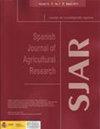Short communication: Veterinary health management in Azorean bovine dairy farms
IF 0.8
4区 农林科学
Q3 AGRICULTURE, MULTIDISCIPLINARY
引用次数: 0
Abstract
Aim of study: To describe veterinary services and farm management practices in cattle dairy farms in São Miguel Island in the Azores and to identify weak points for improvement. Area of study: São Miguel Island, Azores (Portugal). Material and methods: A questionnaire survey was sent to all veterinarians who work in São Miguel Island. It asked about veterinary activity and perceptions of veterinarians working on dairy farms. The van der Waerden test was used to compare the degree of implementation of measures in farms between cooperative veterinarians and private veterinarians. Main results: The overall questionnaire response rate was 67% (20/30). The percentage of veterinarians dedicated to bovine medicine as the main service was 55.6%. Overall, between 40% and 60% of veterinarians implemented a variety of Veterinary Herd Health Medicine (VHHM) programs such as mastitis control, breeding assessment and postpartum management, and the average implementation score of these VHHM, on a 1 to 5 scale, was 2.8 (95% confidence interval: 2.0-3.5). However, other VHHM programs such as biosecurity or hygiene procedures were implemented at a lower rate, ranging between 20% and 30%, and this needs to be improved. Research highlights: Veterinary practicioners in São Miguel Island, Azores still focus their activity more on individual bovine medicine than in VHHM programs; besides, there is room for improvement in the implementation of some of these programs, such as reproduction, hoof health, nutrition, hygiene and biosecurity. This may be a similar situation to that of other regions in the world with a similar production structure.简短交流:亚速尔牛奶牛场的兽医健康管理
研究目的:描述亚速尔群岛奥米格尔岛奶牛养殖场的兽医服务和农场管理做法,并找出需要改进的薄弱环节。研究领域:亚速尔群岛(葡萄牙)的s o Miguel岛。材料与方法:对 o Miguel岛兽医进行问卷调查。它询问了兽医活动和对在奶牛场工作的兽医的看法。采用van der Waerden检验比较合作兽医和私人兽医在农场实施措施的程度。主要结果:总体问卷应答率为67%(20/30)。以牛药为主要服务的兽医占55.6%。总体而言,40%至60%的兽医实施了各种兽医群体健康医学(VHHM)计划,如乳腺炎控制、育种评估和产后管理,这些VHHM的平均执行得分为2.8(95%置信区间:2.0-3.5)。然而,其他VHHM项目,如生物安全或卫生程序的实施率较低,在20%到30%之间,这需要改进。研究重点:亚速尔群岛米格尔岛的兽医从业人员仍然将他们的活动更多地集中在个体牛药物上,而不是VHHM计划;此外,在生殖、蹄健康、营养、卫生和生物安全等一些方案的执行方面还有改进的余地。这可能与世界上具有类似生产结构的其他区域的情况类似。
本文章由计算机程序翻译,如有差异,请以英文原文为准。
求助全文
约1分钟内获得全文
求助全文
来源期刊

Spanish Journal of Agricultural Research
农林科学-农业综合
CiteScore
2.00
自引率
0.00%
发文量
60
审稿时长
6 months
期刊介绍:
The Spanish Journal of Agricultural Research (SJAR) is a quarterly international journal that accepts research articles, reviews and short communications of content related to agriculture. Research articles and short communications must report original work not previously published in any language and not under consideration for publication elsewhere.
The main aim of SJAR is to publish papers that report research findings on the following topics: agricultural economics; agricultural engineering; agricultural environment and ecology; animal breeding, genetics and reproduction; animal health and welfare; animal production; plant breeding, genetics and genetic resources; plant physiology; plant production (field and horticultural crops); plant protection; soil science; and water management.
 求助内容:
求助内容: 应助结果提醒方式:
应助结果提醒方式:


